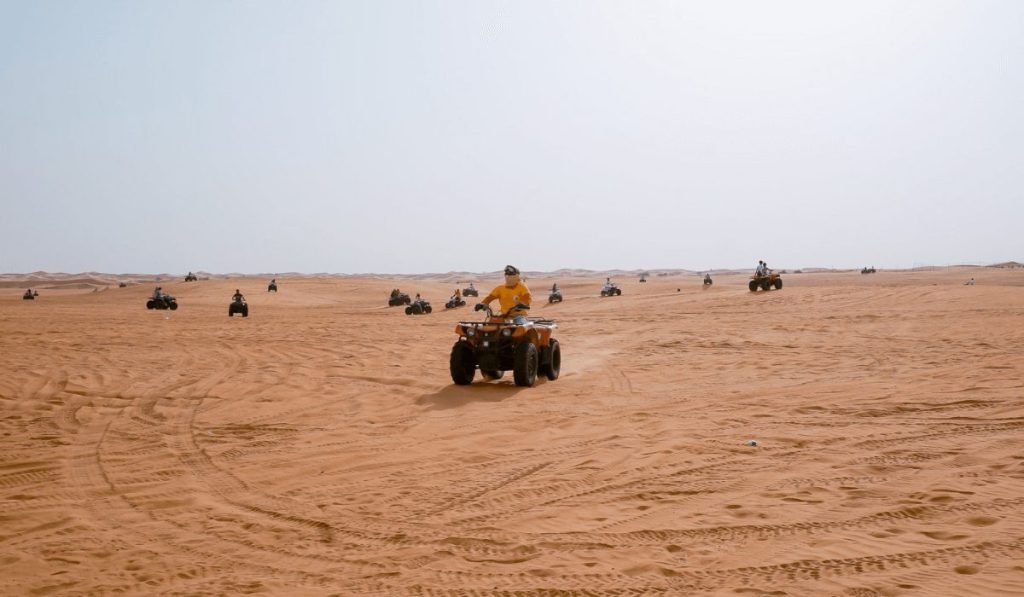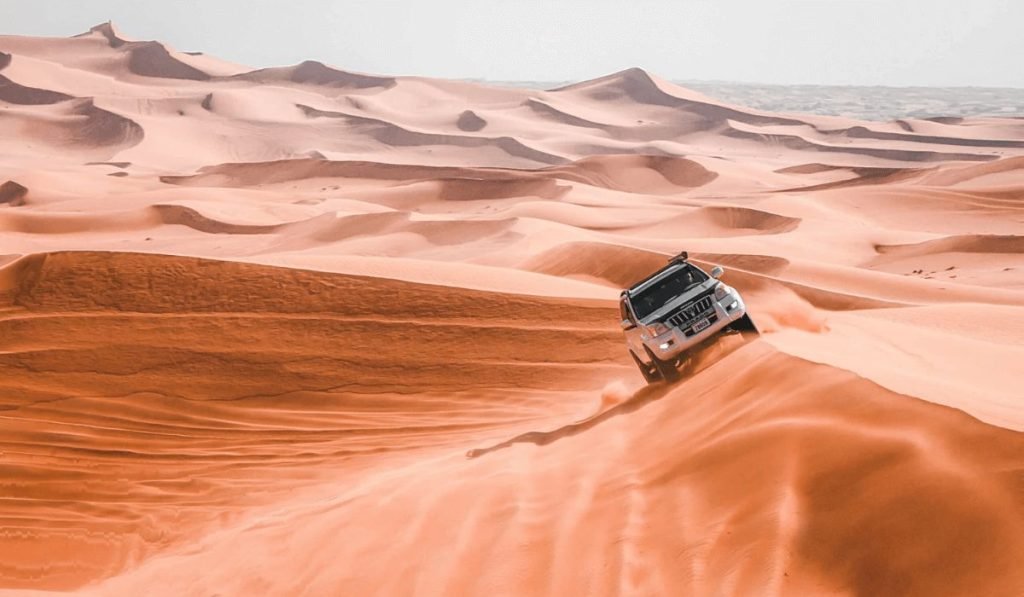Dubai, with its majestic deserts and awe-inspiring landscapes, offers a unique adventure to those seeking an unforgettable desert safari experience. As you embark on this thrilling journey, it’s crucial to prioritize your hydration to ensure a safe and enjoyable trip. In this comprehensive guide, we will delve into the art of staying hydrated during a desert safari in Dubai, equipping you with essential knowledge and practical tips to quench your thirst and make the most out of your adventure.
Understanding the Desert Climate
Dubai’s desert climate presents distinctive challenges when it comes to maintaining proper hydration. The arid environment is characterized by scorching temperatures, low humidity, and high levels of evaporation. These factors can rapidly deplete your body’s water reserves and lead to dehydration if precautions aren’t taken.
Hydration: The Key to a Successful Desert Safari
Hydration forms the cornerstone of a successful desert safari experience. Proper hydration ensures optimal physical and cognitive performance, prevents heat-related illnesses, and enhances overall well-being. Failing to stay adequately hydrated can result in fatigue, dizziness, nausea, and even more severe conditions such as heatstroke. Let’s explore the essential steps to staying hydrated throughout your desert safari.
Preparing for Your Desert Safari

Assessing Your Hydration Needs
Understanding your individual water intake requirements is crucial before embarking on a desert safari. Factors such as age, health, activity level, and the duration of your safari play a significant role in determining the amount of water you should consume. Consulting with a healthcare professional can provide valuable insights tailored to your specific needs.
Stocking Up on Water
Water is the elixir of life, and during a desert safari, it becomes even more essential. It is recommended to bring an ample supply of water, considering the duration of your safari. As a general guideline, aim to carry at least one liter of water per hour of the safari. Additionally, research the availability of water sources along your route to ensure you can replenish your supplies if needed.
Choosing the Right Water Containers
The choice of water containers is essential for keeping your water cool, accessible, and safe during the desert safari. Opt for insulated bottles or hydration packs that can preserve the temperature of your water and protect it from external elements. Additionally, consider the ease of use and portability of the containers to ensure convenience throughout your journey.
Additional Hydration Aids
While water should be your primary source of hydration, incorporating electrolyte-rich beverages or natural fruit juices can enhance your hydration efforts. Electrolytes help replenish essential minerals lost through sweat, maintaining your body’s balance and preventing muscle cramps. However, be mindful of added sugars and opt for natural and low-sugar options whenever possible.
Staying Hydrated During the Desert Safari

Timing Your Hydration
During a desert safari, timing your hydration is crucial to maintain a consistent water intake. Aim to drink water at regular intervals, even before you feel thirsty. By the time thirst sets in, your body may already be on the verge of dehydration. Take proactive sips of water throughout the safari to ensure you remain properly hydrated.
Strategies for Conserving Water
Conserving water is vital in a desert environment where resources may be limited. Implement simple strategies to minimize water loss through sweating. Wear loose-fitting and breathable clothing that allows air circulation, reducing the amount of sweat produced. Additionally, seek shade whenever possible to shield yourself from direct sunlight and reduce water loss through perspiration.
Hydration Breaks and Rest Stops
Plan designated hydration breaks and rest stops along your safari route. These breaks allow you to replenish your water supplies, rest, and restore your energy levels. Look for shaded areas or air-conditioned spots where you can seek refuge from the scorching desert sun. Utilize these breaks to hydrate, reapply sunscreen, and rejuvenate yourself before continuing your adventure.
Utilizing Hydration Tracking Apps
In the digital age, smartphone applications can assist in tracking your water intake during the desert safari. Hydration tracking apps offer user-friendly interfaces, allowing you to monitor your hydration levels and receive timely reminders to drink water. Explore popular hydration tracking apps such as Hydro Coach or Drink Water Reminder to stay on top of your hydration game.
Overcoming Hydration Challenges
Coping with Extreme Heat
Dubai’s desert can subject you to extreme heat conditions, making hydration even more critical. To cope with the intense heat, wear light-colored and loose-fitting clothing that reflects sunlight and facilitates airflow. Protect yourself from direct sun exposure by wearing a wide-brimmed hat, and sunglasses, and using sunscreen with a high SPF rating. If possible, schedule your safari during cooler hours, such as early morning or late afternoon.
Hydration for Children and Elderly Participants
Children and elderly individuals have specific hydration needs during a desert safari. Their bodies may be more susceptible to dehydration due to higher water requirements and potential limitations in thermoregulation. Ensure they have access to water at all times and monitor their hydration levels closely. Plan the safari duration and intensity according to their capabilities and consult with medical professionals if necessary.
Hydration for Individuals with Medical Conditions
If you have any pre-existing medical conditions, it is crucial to consider hydration in consultation with your healthcare provider. Certain conditions may require adjustments in water intake, electrolyte balance, or medication management during a desert safari. Seek medical advice and follow any specific guidelines or precautions recommended by your healthcare professional.
Post-Safari Hydration
Your hydration efforts should not end with the conclusion of the desert safari. After the adventure, focus on rehydration to restore your body’s fluid and electrolyte balance. Drink water or electrolyte-rich beverages to replenish lost fluids and promote recovery. Include hydrating foods such as fruits and vegetables in your post-safari meals to enhance hydration levels naturally.
Conclusion
Mastering the art of hydration during a desert safari in Dubai is crucial to ensure a safe, enjoyable, and memorable experience. By understanding the challenges of the desert climate, preparing adequately, implementing hydration strategies, and overcoming potential obstacles, you can quench your thirst and make the most of your adventure. Remember, staying hydrated isn’t just a matter of quelling your immediate thirst; it’s a commitment to your well-being and investment in the enjoyment of your desert safari. So, hydrate wisely and let the beauty of Dubai’s desert unfold before you!
FAQs
Are there any alternatives to drinking water for hydration?
While water is the most effective and natural source of hydration, there are alternatives to supplement your fluid intake. Natural fruit juices, coconut water, and electrolyte-rich beverages can provide additional hydration and replenish essential minerals lost through sweating. However, be cautious of sugary drinks and opt for low-sugar or sugar-free options whenever possible.
Can I rely on the water provided by the safari tour operator?
It’s recommended to bring your own water supply during a desert safari to ensure you have enough water to stay hydrated. While some safari tour operators may provide water, it’s essential to check beforehand to ensure availability and quantity. Keep in mind that relying solely on the provided water may not be sufficient for your hydration needs, especially in high-temperature environments. It’s always better to be prepared and carry your own water.
What are the signs of dehydration to watch out for?
Dehydration can have various symptoms, and it’s crucial to be aware of the warning signs. Common signs of dehydration include excessive thirst, dry mouth and lips, dark-colored urine, fatigue, dizziness, headache, muscle cramps, and decreased urine output. If you experience any of these symptoms, it’s essential to rest in a shaded area, drink water, and seek medical attention if the symptoms worsen or persist.
Are there any specific medical conditions that require extra hydration measures?
Certain medical conditions may require additional considerations for hydration during a desert safari. Individuals with conditions such as diabetes, kidney disease, heart conditions, or those taking specific medications should consult with their healthcare provider before embarking on a desert safari. They may require adjustments in water intake, electrolyte balance, or medication management to ensure their safety and well-being. Always follow the advice and guidelines provided by your healthcare professional.
How can I track my water intake during the safari?
Tracking your water intake during a desert safari can be helpful in ensuring you stay adequately hydrated. There are several hydration tracking apps available for smartphones that offer user-friendly interfaces and reminders to drink water. Popular apps such as Hydro Coach or Drink Water Reminder allow you to set your water intake goals, monitor your consumption, and receive notifications throughout the day. Additionally, you can use a physical water bottle with volume measurements to track your intake manually. Choose a method that suits your preference and helps you stay mindful of your hydration goals.

